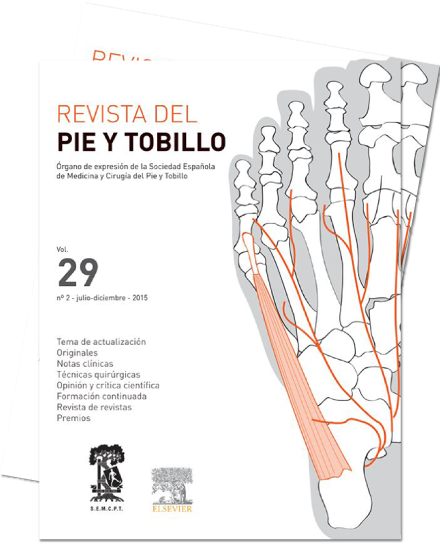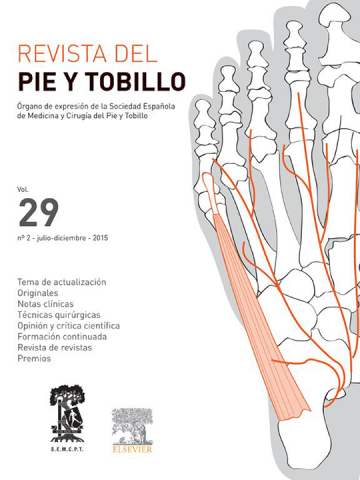Resumen:
Las osteotomías distales del primer metatarsiano han sido indicadas en el tratamiento quirúrgico del hallux rigidus leve y moderado. Su finalidad es realizar un descenso de la cabeza metatarsiana, pero a expensas de un acortamiento del mismo, lo que podría producir en ocasiones una metatarsalgia de transferencia. Realizamos una modificación de una osteotomía distal oblicua, con el objetivo de controlar y evitar un excesivo acortamiento del primer metatarsiano. El objetivo de este estudio es realizar una valoración radiológica del descenso y acortamiento realizados con esta técnica.
Revisamos 32 casos (27 pacientes) intervenidos de hallux rigidus con una osteotomía metatarsiana distal, sin osteotomías asociadas del resto de metatarsianos y con un año mínimo de seguimiento. La osteotomía distal consta de un trazo oblicuo, que se inicia distalmente en el dorso de la cabeza del primer metatarsiano, a 1cm del borde articular, dirigiéndose proximalmente a nivel plantar hasta unos 3cm de la línea articular, con una angulación variable de 10-30° dependiendo del descenso que se desea realizar; y un segundo trazo dorsal perpendicular hasta completar la osteotomía. Los hallux rigidus fueron clasificados según Coughlin y Shurnas. En las radiografías preoperatorias y en las postoperatorias al año de seguimiento se valoró el ángulo intermetatarsiano (AIMT), ángulo metatarso-falángico (AMTF), acortamiento y descenso del primer metatarsiano.
Se clasificaron 3 casos como grado I, 10 como II y 19 como III. El AIMT y el AMTF fueron respectivamente de 9,78° y 17,41° en el preoperatorio y de 5,88° y 4,91° al año. El acortamiento medio fue de 3,66mm y el descenso de 1,91mm.
Esta osteotomía modificada busca la reconstrucción tridimensional del primer metatarsiano en el hallux rigidus. Las ventajas que presenta es ser una osteotomía extraarticular estable, que permite descender adecuadamente la cabeza del primer metatarsiano con un acortamiento controlado del radio, dando una estabilidad rotacional a la cabeza metatarsal.
Abstract:
Distal first metatarsal osteotomies have been indicated in the surgical treatment of mild to moderate hallux rigidus. Its purpose is to decrease the metatarsal head but at the expense of a shortening of the same, which can sometimes produce transfer metatarsalgia. In our center we perform a modification of an oblique distal osteotomy, in order to control and prevent excessive shortening of the first metatarsal. The aim of this study is to perform a radiographic evaluation of the decrease and shortening made with this technique.
We reviewed 32 cases (27 patients) undergoing hallux rigidus distal metatarsal osteotomy with no other metatarsal osteotomies associated with a year minimum follow-up. The distal osteotomy consists on a first oblique cut and it starts distally on the dorsum of the first metatarsal head with a variable angle of 10–30°; and second dorsal perpendicular cut to complete the osteotomy. The hallux rigidus were classified according to Coughlin and Shurnas. In the preoperative and postoperative radiographs at one year follow-up the intermetatarsal angle (IMTA), metatarsal-phalangeal angle (MTPA), shortening and lowering of the first metatarsal were assessed.
3 cases were grade I, 10 as II and 19 were classified as III. The IMTA and MTPA were respectively 9.78° and 17.° preoperatively and 5.88° and 4.91° per year. The average shortening was 3.66 mm and the lowering 1.91mm.
This modified osteotomy looks for a three-dimensional reconstruction in the treatment of hallux rigidus. The advantages are to be a stable extraarticular osteotomy, which allows properly lowering the first metatarsal head with controlled shortening of the radius, giving a rotational stability to the metatarsal head.





